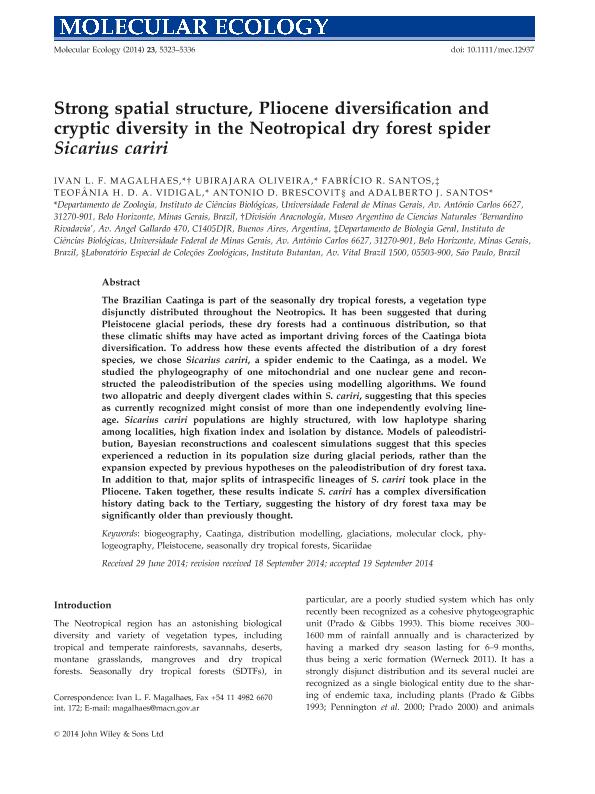Mostrar el registro sencillo del ítem
dc.contributor.author
Fiorini de Magalhaes, Ivan Luiz

dc.contributor.author
Oliveira, Ubirajara
dc.contributor.author
Santos, Fabricio R.

dc.contributor.author
Vidigal, Teofania Heloisa Dutra Amorim

dc.contributor.author
Brescovit, Antonio Domingos

dc.contributor.author
Santos, Adalberto J.
dc.date.available
2019-09-25T21:49:25Z
dc.date.issued
2014-11
dc.identifier.citation
Fiorini de Magalhaes, Ivan Luiz; Oliveira, Ubirajara; Santos, Fabricio R.; Vidigal, Teofania Heloisa Dutra Amorim; Brescovit, Antonio Domingos; et al.; Strong spatial structure, Pliocene diversification and cryptic diversity in the Neotropical dry forest spider Sicarius cariri; Wiley Blackwell Publishing, Inc; Molecular Ecology; 23; 21; 11-2014; 5323-5336
dc.identifier.issn
0962-1083
dc.identifier.uri
http://hdl.handle.net/11336/84490
dc.description.abstract
The Brazilian Caatinga is part of the seasonally dry tropical forests, a vegetation type disjunctly distributed throughout the Neotropics. It has been suggested that during Pleistocene glacial periods, these dry forests had a continuous distribution, so that these climatic shifts may have acted as important driving forces of the Caatinga biota diversification. To address how these events affected the distribution of a dry forest species, we chose Sicarius cariri, a spider endemic to the Caatinga, as a model. We studied the phylogeography of one mitochondrial and one nuclear gene and reconstructed the paleodistribution of the species using modelling algorithms. We found two allopatric and deeply divergent clades within S. cariri, suggesting that this species as currently recognized might consist of more than one independently evolving lineage. Sicarius cariri populations are highly structured, with low haplotype sharing among localities, high fixation index and isolation by distance. Models of paleodistribution, Bayesian reconstructions and coalescent simulations suggest that this species experienced a reduction in its population size during glacial periods, rather than the expansion expected by previous hypotheses on the paleodistribution of dry forest taxa. In addition to that, major splits of intraspecific lineages of S. cariri took place in the Pliocene. Taken together, these results indicate S. cariri has a complex diversification history dating back to the Tertiary, suggesting the history of dry forest taxa may be significantly older than previously thought.
dc.format
application/pdf
dc.language.iso
eng
dc.publisher
Wiley Blackwell Publishing, Inc

dc.rights
info:eu-repo/semantics/openAccess
dc.rights.uri
https://creativecommons.org/licenses/by-nc-sa/2.5/ar/
dc.subject
BIOGEOGRAPHY
dc.subject
CAATINGA
dc.subject
DISTRIBUTION MODELLING
dc.subject
GLACIATIONS
dc.subject
MOLECULAR CLOCK
dc.subject
PHYLOGEOGRAPHY
dc.subject
PLEISTOCENE
dc.subject
SEASONALLY DRY TROPICAL FORESTS
dc.subject
SICARIIDAE
dc.subject.classification
Zoología, Ornitología, Entomología, Etología

dc.subject.classification
Ciencias Biológicas

dc.subject.classification
CIENCIAS NATURALES Y EXACTAS

dc.title
Strong spatial structure, Pliocene diversification and cryptic diversity in the Neotropical dry forest spider Sicarius cariri
dc.type
info:eu-repo/semantics/article
dc.type
info:ar-repo/semantics/artículo
dc.type
info:eu-repo/semantics/publishedVersion
dc.date.updated
2019-09-24T12:51:53Z
dc.journal.volume
23
dc.journal.number
21
dc.journal.pagination
5323-5336
dc.journal.pais
Reino Unido

dc.journal.ciudad
Londres
dc.description.fil
Fil: Fiorini de Magalhaes, Ivan Luiz. Universidade Federal de Minas Gerais. Instituto de Ciências Biológicas; Brasil. Consejo Nacional de Investigaciones Científicas y Técnicas. Oficina de Coordinación Administrativa Parque Centenario. Museo Argentino de Ciencias Naturales “Bernardino Rivadavia”; Argentina
dc.description.fil
Fil: Oliveira, Ubirajara. Universidade Federal de Minas Gerais. Instituto de Ciências Biológicas; Brasil
dc.description.fil
Fil: Santos, Fabricio R.. Universidade Federal de Minas Gerais. Instituto de Ciências Biológicas; Brasil
dc.description.fil
Fil: Vidigal, Teofania Heloisa Dutra Amorim. Universidade Federal de Minas Gerais. Instituto de Ciências Biológicas; Brasil
dc.description.fil
Fil: Brescovit, Antonio Domingos. Governo do Estado de Sao Paulo. Secretaria da Saude. Instituto Butantan; Brasil
dc.description.fil
Fil: Santos, Adalberto J.. Universidade Federal de Minas Gerais. Instituto de Ciências Biológicas; Brasil
dc.journal.title
Molecular Ecology

dc.relation.alternativeid
info:eu-repo/semantics/altIdentifier/doi/http://dx.doi.org/10.1111/mec.12937
dc.relation.alternativeid
info:eu-repo/semantics/altIdentifier/url/https://onlinelibrary.wiley.com/doi/abs/10.1111/mec.12937
Archivos asociados
